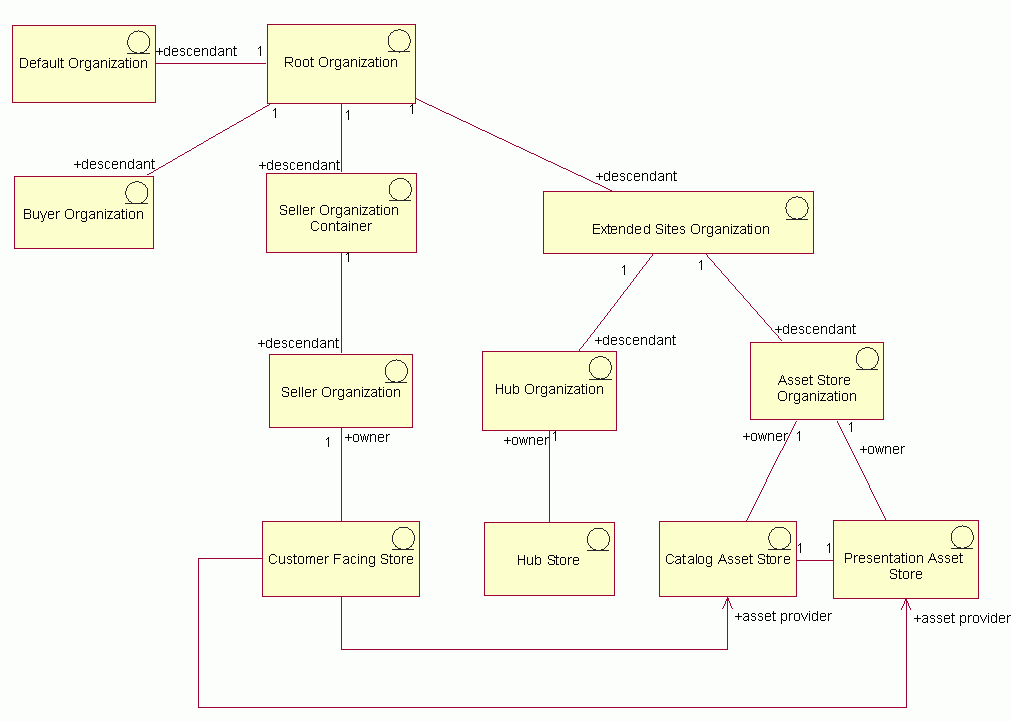
Extended sites information model
Extended Sites, one of the predefined business models in WebSphere Commerce, is used when a seller can have many sites that are aimed at different audiences. For example, a seller can create sites that are based on geographical regions, while some customized sites can be created for individual large customers. All these different sites can share assets such as the catalog. Each site can select the subset of the catalog that is presented, and adjust the prices as necessary.
The extended sites business model allows a business, or enterprise to use multiple strategies to make its products available to customers. Many different sites can be presented to the market and each is perceived by customers as unique. The business can customize sites by: Geography, brand, market segment, or customer.
The following diagram shows a UML representation of the extended sites information model.

- Root Organization
- All organizations in the business become descendants of the root organization. As well, the administrators that maintain the online site, the Site Administrators, are added directly under the root.
- Default Organization
- Customers who do not register as part of a buyer organization, but as individuals, belong to the default organization.
- Buyer Organization
- Customers, which are known in B2B direct businesses as buyers, are represented by a buyer organization in the B2B organization structure. Individual users who belong to buyer organizations, must register under their respective organization.
- Seller Organization Container
- A Seller organization container holds any number of seller organizations. By having stores under different seller organizations, you have more flexibility in terms of access control for customers and administrators.
- Seller Organization
- The seller organization is created to own all of the stores. A child organization unit is created for each store.
- Extended Sites Organization
- The extended sites organization is created to own all of the extended sites store related organizations (with the exclusion of the organization that owns the stores). The extended sites organization owns the following child organizational units:
- Asset Store Organization
- A child organization of the Extended Sites Organization. The asset store organization is created to own all assets that are used to create stores.
- Hub Organization
- A child organization of the Extended Sites Organization. The extended sites hub organization is created to own the extended sites hub. The administrators that maintain the extended sites hub functions and administer the extended sites organization are termed channel administrators and are owned directly by the extended sites hub organization.
- Hub Store
- A store that enables partners or clients. In the extended sites business model, the hub store can be a store directory.
- Customer Facing Store
- An online site where users can obtain information about products, and conduct business
transactions over these products. Business transactions can include retail purchases, transactions
between businesses and transactions between a government organization and citizens or businesses.
WebSphere Commerce uses the generic term 'store' to describe the online space where all of these
business transactions take place. A customer facing store needs to link to a presentation asset
store to inherit the storefront assets, such as store pages and content, to display to shoppers. The
customer facing store can also link to a catalog asset store to inherit the catalog assets, such as
products and categories, to present to shoppers. The link to a catalog asset store is optional.
Catalog assets can be created within the customer facing store.Note: Linking a customer facing store to a single presentation asset store and a single catalog asset store is the typical extended sites configuration. Linking the customer facing store to more than one presentation asset store or catalog asset store is not a tested or supported configuration.
- Catalog Asset Store
- A catalog of goods for sale, containing pricing and currency information. The catalog asset store provides catalog assets to customer facing stores and to presentation asset stores. Presentation asset stores can use catalog assets to create storefront assets, such as marketing promotions that recommend catalog entries. Customer facing stores display the catalog assets from the catalog asset store. The catalog asset store does not need to inherit assets from any other store.
- Presentation Asset Store
- The Presentation Asset Store consists of web assets such as HTML pages, JSP files, style sheets, images, graphics, and other multimedia file types. You can also define shipping methods, shipping charges, marketing promotions, and contracts assets. To define storefront assets to use catalog assets, such as a marketing promotion that recommends catalog entries, the presentation asset store must link to a catalog asset store. Users that are working in a presentation asset store can then access the catalog asset information to create storefront assets that are based on the catalog assets. An extended sites organization can include multiple presentation asset stores, which can each link to the same catalog asset store.